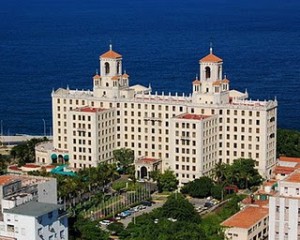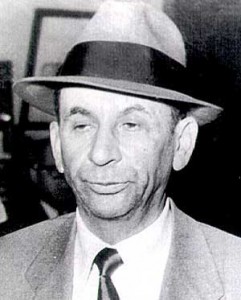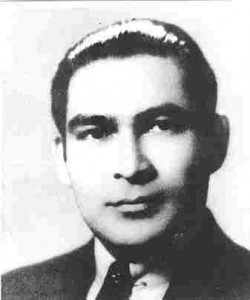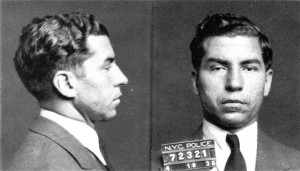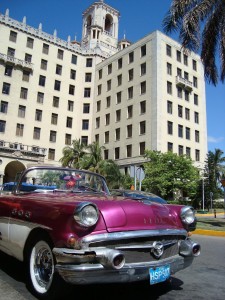![]() THE COSA NOSTRA “Havana Conference”. The Whole Story.
THE COSA NOSTRA “Havana Conference”. The Whole Story.
In early fall 1946 while “Exile” in Rome, Italy, Salvatore “Charlie Lucky” Luciano, a leader of organized crime in the U.S. received word from a new U.S. deportee in the form of a sealed envelope. The message consisted of three words, “December-Hotel Nacional.” In late September Luciano obtained two Italian passports made out in his real name, Salvatore Lucania, with visas for Mexico, Cuba, and several South American nations in his way to The Havana Conference.
The Havana Conference of 1946 was an historic meeting of United States Mafia and Cosa Nostra leaders in Havana, Cuba. The conference was held to discuss important mob policies, rules, and business interests. The Havana Conference was attended by delegations representing crime families throughout the United States. The conference was held during the week of December 22, 1946 at the Hotel Nacional. This ‘Conference’ is considered to have been the most important mob summit since the Atlantic City Conference of 1929. Decisions made in Havana resonated throughout the US crime families for the ensuing decades.
Meyer Lansky greeted his old friend on his arrival in Cuba. Lansky had organized the summit for the week of 22 December on Luciano’s orders. Lansky quickly suggested to Luciano that he should purchase a $150,000 interest in the Hotel Nacional and a casino operated and owned by Meyer and his silent partner, Cuban President Batista y Zaldívar. Luciano agreed and the Havana Conference was set.
The meeting concerned mainly La Cosa Nostra business, but several National Syndicate Bosses were also invited to attend. Frank Sinatra was also invited to Cuba the week of the conference for a gala party, but he was not there as a conference attendee. Sinatra’s party was, however, used as a pretext for the Bosses to be in Havana. Sinatra flew to Havana with three members of the Chicago delegation, Capone cousins, Charlie, Rocco and Joseph Fischetti. Joseph Fischetti was there as Sinatra’s chaperone, while Charlie and Rocco attended the meeting and also had the job of delivering a suitcase with $2 million to Lucky Luciano, his share of the U.S. rackets he still controlled. On the agenda for the Bosses were topics such as the Havana casino and business interests they controlled, the “Boss of Bosses” title, narcotics operations and the “West Coast” operations of Benjamin “Bugsy” Siegel. Charlie Luciano also had a couple of personal items to address.
The most pressing items on the conference agenda were the leadership and authority within the New York mafia, the mob-controlled Havana casino interests, the narcotics operations, and the West Coast operations of Benjamin “Bugsy” Siegel, especially the new Flamingo Hotel and casino in Las Vegas. Luciano, absent from the American underworld scene for several months, was especially concerned with the situation in New York. Boss Vito Genovese had returned to New York from exile in Italy and was not content with assuming a minor role in the organization.
The Conference begins
The Havana Conference convened on December 22, 1946. Delegates were present representing New York City, New Jersey, Buffalo, Chicago, New Orleans and Florida, with the largest delegation of bosses from the New York-New Jersey area. Several major bosses from the Jewish Syndicate were at the conference to discuss joint La Cosa Nostra-Jewish Syndicate business. According to conference rules, the Jewish delegates could not vote on Cosa Nostra rules or policies; however, the Jewish crime bosses were allowed input on any joint business ventures, such as the Flamingo Hotel.
Luciano opened the Havana Conference by discussing a topic that would greatly affect his authority within the American Mafia; the position of “capo di tutti capi” or “boss of all bosses”. The last official boss of all bosses had been Salvatore Maranzano, who was murdered in September 1931. By the end of 1931, Luciano had eliminated this top position and re-organized the Italian mafia into “La Cosa Nostra”, or “This Thing of Ours”. A board of directors, commonly called the “Commission”, had been formed to oversee criminal activities, control rules, and set policies. La Cosa Nostra thus became the top criminal organization within the National Crime Syndicate.
Now Luciano could easily have declared himself as Maranzano’s heir in 1932; instead, Luciano decided to exercise control behind the scenes. This arrangement had worked until Vito Genovese’s return from Italy. Officially, Genovese was now just a caporegime; however, he had made it clear that he intended to take control of the Luciano crime family. Since Luciano’s deportation in 1946, Luciano ally, Frank Costello had been the acting boss of the Luciano family. As a result, tensions between the Costello and Genovese factions had started to fester. Luciano had no intention of stepping down as family boss; he had to do something about Genovese. Luciano also realized that Genovese threatened his overall authority and influence within the American mafia, probably with support from other crime bosses. Therefore, Luciano decided to resurrect the boss of all bosses position and claim it for himself. He hoped the other bosses would support him, either by officially affirming the title or at least by acknowledging that he was still “First Amongst Equals”.
At the conference, Luciano allegedly presented the motion to retain his position as the top boss in La Cosa Nostra. Then Luciano ally, Albert “The Mad Hatter” Anastasia seconded the motion. Anastasia voted with Luciano because he felt threatened by Genovese’s attempts to muscle in on his waterfront rackets. Checkmated by the Luciano-Costello-Anastasia alliance, Genovese was forced to swallow his ambitions and plan for the future. To further embarrass Genovese, Luciano encouraged Anastasia and Genovese to settle their differences and shake hands in front of the other bosses. This symbolic gesture was meant to prevent another bloody gang war such as the Castellammarese War of 1930-1931. With Luciano solidifying his personal position and squashing Genovese’s ambition for now, Luciano brought up discussion of the mob’s narcotics operations in the United States.
Narcotics Deal.
One of the key topics at the Havana Convention was the global narcotics trade and the mob’s operations in the United States. A longstanding myth has been the supposed refusal of Luciano and the Cosa Nostra to deal in narcotics. In reality, only a few bosses such as Frank Costello and the other bosses who controlled lucrative gambling empires opposed narcotics. The anti-drug faction believed that the Cosa Nostra did not need narcotics profits, that narcotics brought unwanted law enforcement and media attention, and that the general public considered it to be a very harmful activity (unlike gambling). The pro-drug faction said that narcotics were far more profitable than any other illegal activity. Furthermore, if the Cosa Nostra ignored the drug trade, other criminal organizations would jump in and eventually diminish the Cosa Nostra’s power and influence.
La Cosa Nostra has long been involved in the narcotics business and was the biggest importer of narcotics (heroin, cocaine, marijuana) in the United States from the 1920s-80’s, until the emergence of the Latin, Asian and Middle East drug lords (Colombians, Mexicans, Chinese, Vietnamese, Turkish & Pakistani) and their organizations. The Havana Conference was the beginning of Lucky Luciano’s and the Mob’s move to monopolize the narcotics business. Charlie Luciano’s deportation put him in a position to lead the one of the largest narcotics importation and distribution operations ever, “The French Connection.” He then organized the first U.S. and Sicilian La Cosa Nostra Summit at The Grand Hotel des Palmes in Palermo, Sicily from October 10-14, 1957, which led to the eventual formation of the “Pizza Connection” narcotics operation.
The American Mafia’s longtime association with the government of Cuba concerning gambling interests such as casinos along with their legitimate business investments on the Caribbean island put them in a position to use their political and underworld connections to make Cuba one of their narcotics importation layovers or smuggling points where the drugs could be stored and then placed on sea vessels before they continued on to Canada and United States via Montreal and Florida among the ports used by Luciano’s associates.
During the Havana Conference, Luciano detailed the proposed drugs network to the bosses. After arriving in Cuba from North Africa, the mob would ship the narcotics to US ports that it controlled, primarily New York City, New Orleans, and Tampa. The narcotics shipped to the New York docks would be overseen by the Luciano crime family (later the Genovese) and the Mangano crime family (later the Gambino). In New Orleans, the operation would be overseen by the Marcello crime family, led by Carlos “Little Man” Marcello. In Tampa, the narcotics shipments would be overseen by the Trafficante crime family led by Santo Trafficante, Jr.. The Havana Convention delegates voted to approve the plan.
The Luciano narcotics empire continued to grow and prosper with the help of his U.S. associates. Many of Luciano’s partners in the narcotics empire were “Havana Conference” delegates such as Joseph “The Old Man” Profaci who was once the biggest importer of olive oil and tomato paste in the United States and quietly used his food importation business to smuggle narcotics for decades, Gaetano “Tommy Brown” Lucchese, a longtime Luciano ally from their days as children in the streets of New York and who along with his Lucchese crime family’s narcotics distribution arm, the 107th St. Crew which controlled all heroin distribution in Harlem, New York. Without a doubt one of the architects of the American heroin network and a partner of Luciano is well known and powerful New York mafia boss, Joseph “Joe Bananas” Bonanno, the patriarch of the Bonanno crime family, who along with the assistance of his cousin, Buffalo crime family boss, Stefano “The Undertaker”
When Cuban President y Zaldivar was eventually overthrown by Fidel Castro in 1959, the mob had to look elsewhere for a landing and storage facility for their narcotics shipments.
The Siegel Situation
The next item on the agenda at the Havana Conference was what Lansky called the “Siegel Situation”. In the mid 1930s, the New York and Chicago crime families had been sent out west to set up and oversee a race wire service, gambling activities in Los Angeles and Nevada, and supervise narcotics shipments from Mexico. In a short while, Benjamin “Bugsy” Siegel had become a very popular and visible figure in Hollywood’s most glamorous circles.The Flamingo Hotel was the creation of Billy Wilkerson, a Hollywood nightclub owner and one of the founders of “The Hollywood Reporter”. By the mid-1940s, it was an unfinished dream deferred. This Flamingo Hotel project became Siegel’s obsession. Siegel persuaded his longtime friend and business associate Meyer Lansky to help him sell New York and Chicago crime bosses on investing in this project. Siegel promised the bosses that the hotel and casino would be a smart and profitable investment.
However, the Flamingo project immediately ran into problems. Siegel appointed his girlfriend Virginia Hill as a project overseer. As a result, contractors were stealing Siegel blind; they would sell him materials one day, then steal them from the building site at night, then resell them to Siegel the next day.[citation needed] The Flamingo project was also impacted by the rising cost of materials and labor from the post World War II building boom. The bottom line was that a project projected to cost $1.5 million would eventually reach $6 million.
To make matters worse, the bosses suspected Siegel and Hill of stealing project money. Lansky and the bosses had discovered that Hill was taking frequent trips to Zürich, Switzerland and depositing money in a bank account. They suspected that Siegel was skimming money and might flee the country if the Flamingo failed.
Following a discussion, the delegates voted to execute Siegel. The delegates assigned Chicago Outfit consigliere, Charles “Trigger Happy” Fischetti to oversee the contract. The actual hit would be given to Jack Dragna, the Los Angeles crime family boss and close to Siegel. Dragna, who despised Siegel, then gave the contract to Mob hitman, John “Frankie” Carbo, a Lucchese crime family soldier. On June 20, 1947, Siegel was home alone at Hill’s mansion in Los Angeles reading a newspaper by a living room window. A gunman with an army carbine rose up from the bushes and fired four shots into the room. Siegel was hit twice in the head and twice in the torso and died instantly.
Lucky and Don Vito
At the end of the Havana Conference, the tension between Luciano and Genovese allegedly reached a boiling point, according to “The Last Testament of Lucky Luciano”, by Martin Gosch and Richard Hammer. Meeting with Luciano in his room at the Hotel Nacional, Genovese told him that the U.S. government knew that Luciano was in Cuba and was pressuring the Cuban Government to expel him. Since Luciano was going to have to return to Italy, he should turn over leadership of the Luciano Family to Genovese and retire. Positive that Genovese had tipped off the US government to his presence in Cuba, Luciano finally snapped. He proceeded to beat Genovese and eventually broke three of his ribs; it was three days before Vito could travel again. When Genovese felt better, Luciano and Anastasia then put Genovese on a plane to the States. Luciano also threatened to kill Genovese if he ever mentioned this incident to anyone. While Luciano knew that Vito Genovese had tipped off the U.S. government to his whereabouts in Cuba, he did not live to find out was that it was “Joe Bananas” Bonanno who tipped off the New York City papers to Luciano’s whereabouts in Cuba in February 1947. Joseph Bonanno was a very respected and feared Don who was also ruthless and very ambitious and always had aspired to being crowned capo di tutti capi, “boss of bosses” just like his former boss and mentor Salvatore Maranzano. This information of Joseph Bonanno’s treachery was picked up by former F.B.I. agent William Roemer, who was given the information by several of his former F.B.I. colleagues
In February 1947, the New York City papers got wind of the fact that Luciano was in Cuba. U.S. drug agent Harry Anslinger (called that S.O.B Asslinger by Luciano) demanded that Cuba deport Luciano to Italy. Anslinger claimed that Luciano was behind the recent surge of heroin into the United States. When Cuba refused to comply, Anslinger took his case to President Harry S. Truman. The U.S. government then halted all shipments of medical supplies to Cuba while Luciano was still on the island. Luciano, Lansky, and Cuban President Batista tried to strike back by halting all Cuban sugar exports to the US, but it had no effect on Washington. Later in February, the Cubans caved in; they arrested Luciano and sent him back to Italy. When his plane landed there, the Italians arrested Luciano, but released him soon after.
Lucky Luciano died on January 26, 1962, of a heart attack at the Naples, Italy airport while picking up movie producer Martin Gosch.
Martin Gosch had helped Luciano write an autobiographical screenplay, but the Mafia Commission wouldn’t allow the film to be made. Gosch along with Richard Hammer used the screenplay to write the book, “The Last Testament of Lucky Luciano” in 1975.
Luciano’s longtime associate and eventual nemesis, Vito Genovese, died a natural death in the Atlanta Federal Penitentiary in 1969. Ironically, Luciano and Genovese ended up being buried 100 feet from each other in the same cemetery in New York.
Havana Conference attendees
List of the organized crime figures who attended the Havana Conference on December 22, 1946 at the Hotel Nacional in Havana, Cuba.
Host
Charlie “Lucky” Luciano, former Luciano family boss, former chairman, co-founder and member of the Commission. Luciano was living in Naples, Italy. After the meeting he was named America’s boss of bosses.
Meyer “The Little Man” Lansky, Jewish Syndicate boss, a top financial and gambling operations advisor for the Italian mafia in America and casino operations front man (Las Vegas, Cuba, Bahamas)
New York-New Jersey Delegation
* Frank “The Prime Minister” Costello, Luciano family boss, Commission member.
* Quarico “Willie Moore” Moretti, Luciano Family Underboss.
* Albert “The Mad Hatter” Anastasia, Mangano Family Underboss and future boss.
* Joseph “Joe Bananas” Bonanno, Bonanno Family boss, charter Commission member.
* Gaetano “Tommy Brown” Lucchese, Gagliano Family Underboss and future boss.
* Giuseppe “The Old Man” Profaci, Profaci Family boss, charter Commission member.
* Giuseppe “Fat Joe” Magliocco, Profaci Family Underboss.
* Vito “Don Vito” Genovese, Luciano Family caporegime and future boss.
* Giuseppe “Joe Adonis” Doto, Luciano Family caporegime.
* Anthony “Little Augie Pisano” Carfano, Luciano Family caporegime.
* Michele “Big Mike” Miranda, Luciano Family caporegime and future Consigliere.
Chicago Delegation
* Anthony “Joe Batters” Accardo, Chicago Outfit boss, Commission member.
* Charles “Trigger Happy” Fischetti, Chicago Outfit Consigliere.
* Rocco Fischetti, Chicago Outfit Captain.
Buffalo Delegation
* Stefano “The Undertaker” Magaddino, Buffalo Family boss, charter Commission member.
New Orleans Delegation
* Carlos “Little Man” Marcello, New Orleans Family boss (some mob historians dispute his position at this time).
Tampa Delegation
* Santo “Louie Santos” Trafficante Jr., Tampa Family caporegime, moved to Havana in 1946 to oversee La Cosa Nostra and Tampa Family casino and business interests, future Tampa Family boss.
Jewish Syndicate Delegation
* Abner “Longy” Zwillman, New Jersey Jewish Syndicate boss, National Syndicate Commission member.
* Morris “Moe” Dalitz, Cleveland Jewish Syndicate boss, casino front man (Desert Inn, Las Vegas)
* Joseph “Doc” Stacher, New Jersey Jewish Syndicate boss, casino front man (Sands Hotel, Las Vegas)
* Philip “Dandy Phil” Kastel, Jewish Syndicate boss, Frank Costello’s Louisiana slots operations and Tropicana Casino, Las Vegas partner.
Note: The film The Godfather Part II has an homage to the Havana Conference when Michael Corleone travels to Havana to have a meeting with several other mob bosses.
Agencies/lacndb/InternetPhotos/Arnoldo Varona/ TheCubanHistory.com
THE CUBAN HISTORY, HOLLYWOOD.
CUBA PHOTOS.



